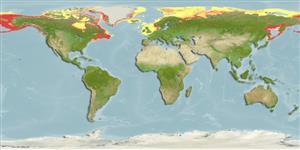Teleostei (teleosts) >
Perciformes/Zoarcoidei (Eelpouts and pricklebacks) >
Lumpenidae (Eel pricklebacks)
Etymology: Anisarchus: Greek, anisos = unequal + Greek, archos = anus (Ref. 45335).
Environment: milieu / climate zone / depth range / distribution range
Ecology
Marine; demersal; depth range 10 - 300 m (Ref. 50550), usually 30 - 100 m (Ref. 10571). Polar; 85°N - 41°N, 180°W - 180°E
North Pacific: Bering Sea to Japan and southeastern Alaska. Northwest Atlantic: Arctic to western Greenland and Labrador, Canada. Northeast Atlantic: Norway, Russia and Spitsbergen (Ref. 10571).
Size / Weight / Age
Maturity: Lm ? range ? - ? cm
Max length : 30.0 cm TL male/unsexed; (Ref. 56557); common length : 12.0 cm TL male/unsexed; (Ref. 10571)
Dorsal soft rays (total): 0. Caudal fin rounded (Ref. 10571). Body light yellowish, usually with faint darker patches (Ref. 10571).
Found on muddy bottoms, generally preferring water below 0°C and salinities above 30 ppt. (Ref. 10571). Benthic (Ref. 58426). Feeds on small benthic invertebrates (Ref. 10571).
Life cycle and mating behavior
Maturity | Reproduction | Spawning | Eggs | Fecundity | Larvae
Eschmeyer, W.N., E.S. Herald and H. Hammann, 1983. A field guide to Pacific coast fishes of North America. Boston (MA, USA): Houghton Mifflin Company. xii+336 p. (Ref. 2850)
IUCN Red List Status (Ref. 130435: Version 2024-2)
Threat to humans
Harmless
Human uses
Tools
Special reports
Download XML
Internet sources
Estimates based on models
Preferred temperature (Ref.
123201): -1.6 - 4.1, mean -0.6 °C (based on 2071 cells).
Phylogenetic diversity index (Ref.
82804): PD
50 = 0.7505 [Uniqueness, from 0.5 = low to 2.0 = high].
Bayesian length-weight: a=0.00324 (0.00161 - 0.00651), b=2.95 (2.77 - 3.13), in cm total length, based on LWR estimates for this species & (Sub)family-body (Ref.
93245).
Trophic level (Ref.
69278): 3.2 ±0.36 se; based on food items.
Resilience (Ref.
120179): Medium, minimum population doubling time 1.4 - 4.4 years (Preliminary K or Fecundity.).
Fishing Vulnerability (Ref.
59153): Low vulnerability (20 of 100).
🛈
